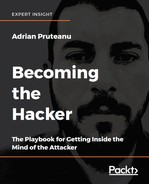In this chapter, we looked at tools, environments, and the bare minimum ROE we must follow during engagements. We stressed how important communication is and how critical it is to consider client privacy while testing. We are not the bad guys and we cannot operate with impunity. We've also gone over the clean - up process and it is vital that we leave no artifacts, unless otherwise requested by the client. Our leftover shells should not be the feature of a future breach.
We've also covered the penetration tester's toolkit; an all-in-one Linux distribution, Kali; and a couple of its alternatives. The more important piece to a web application hacker's toolkit is arguably the attack proxy, two of which we've highlighted: Burp Suite and ZAP. Finally, we've mentioned the cloud as an emerging useful tool for the web application tester.
The attacker's job will always be easier than that of the defender. Any professional hacker with experience in the corporate world will attest to this. The attacker needs just one weak link in the chain — even if that weakness is temporary — to own the environment completely.
Security is difficult to do right the first time and it is even more difficult to keep it close to the baseline as time passes. There are often resourcing issues, lack of knowledge, or wrong priorities, including simply making the organization profitable. Applications have to be useable — they must be available and provide feature enhancements to be useful. There never seems to be enough time to test the code properly, let alone to test it for security bugs.
Staff turnover can also lead to inexperienced developers shipping insufficiently-tested code. The security team is often stretched thin with daily incidents, let alone having the time to be bothered with secure code reviews. There is no silver bullet for security testing applications and there is rarely enough money in the budget. There are many pieces to this puzzle and many factors that act against a completely secure application and underlying infrastructure.
This is where the professional hacker, who understands these limitations, can shine. With shell access to a server, one can search for a potential privilege escalation exploit, try to get it working, and, after some trial and error, gain full access. Alternatively, one could take advantage of the fact that inter-server communication is a common sysadmin requirement. This means that connections between servers are either passwordless, or that the password is improperly stored somewhere close by. It's not uncommon to find unprotected private keys in globally-readable directories, allowing access to every other server in the infrastructure. Secure Shell (SSH) private keys, frequently used in automating SSH connections, are not password protected because password protecting a private key will break the automation script that is using it.
In upcoming chapters, we will use these unfortunate truths about application development and deployment to our advantage.
